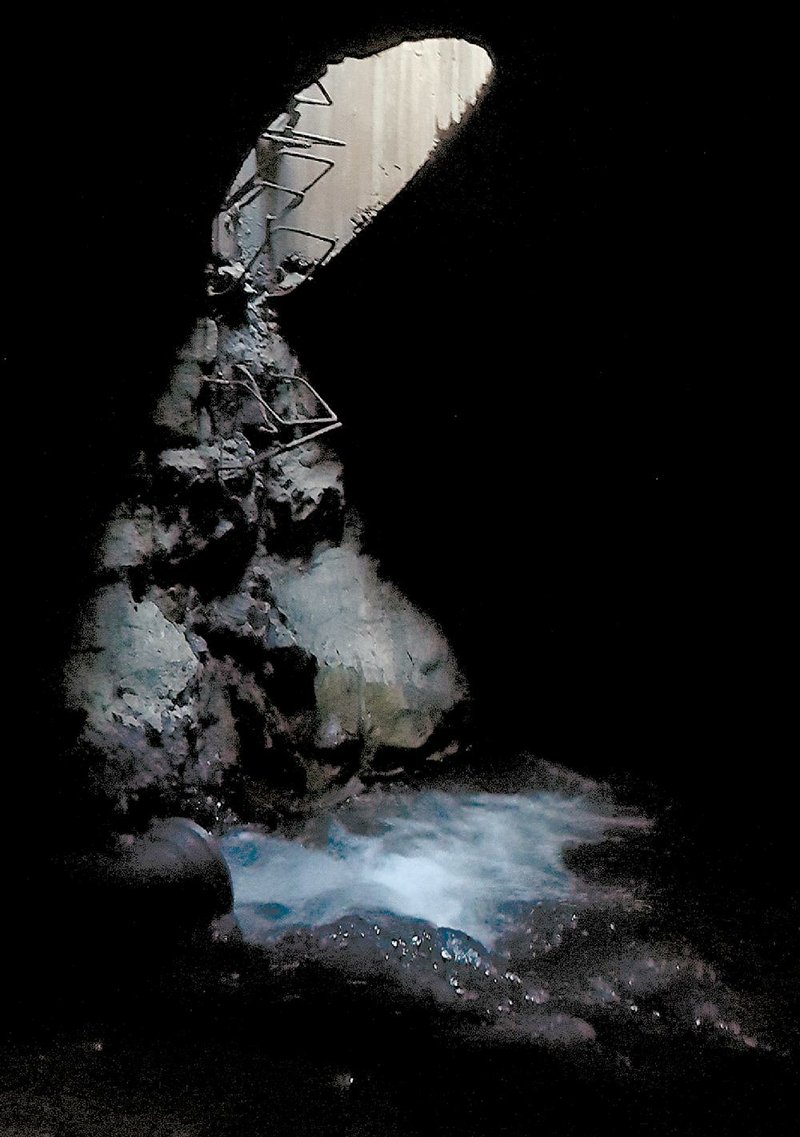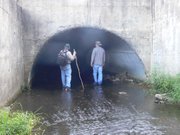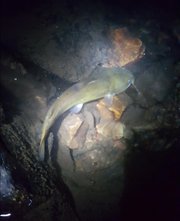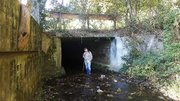HOT SPRINGS -- When I was young, I told people I longed to go on eccentric adventures, like bicycling across the nation or floating down the Mississippi River to New Orleans in a homemade raft. They told me I would outgrow such yearnings. They were wrong.
RELATED ARTICLE
http://www.arkansas…">Unnoticed, tunnel big part of history
Now that I'm 75, when I announce one of my bird-brained adventure ideas, they say, "You are too old, too feeble. Too weak."
They may be right. But there is a person in my life who doesn't say, "too old." Instead, he asks, "Doc. Can I go with you?"
My oldest grandson, Evan Smedley, is 23 years old and a senior at Henderson State University in Arkadelphia. He works in a canoe rental business on the Caddo River and, if truth be told, his religion is fly-fishing.
Late last summer, I decided that I wanted to hike through the aqueduct that carries Hot Springs Creek beneath Central Avenue under downtown Hot Springs. Evan's professor had mentioned it in his Arkansas history class, and so he wanted to go with me. We read about the 2 miles of underground waterways, and the old historic part of the tunnel in Hot Springs National Park literature. But we knew nothing about the current condition of the tunnel.
Built in 1884 out of native stone laid in a keystone arch design, the tunnel supports a roadway in front of Bathhouse Row and channels what was once a smelly waterway to the southern end of the city. It also provides a measure of flood control from occasional downpours that flow off Hot Springs, Sugarloaf and West mountains.
ASSUMPTIONS
We imagined that the tunnel would be full of rats, snakes and cobwebs. We thought we could just enter the tunnel without approval from the powers that be. We thought perhaps the tunnel would be a hangout for the homeless or criminal element. We
assumed it would be filled with graffiti, smell bad, be muddy, have a slimy-slippery bottom, and that we might be forced to swim for short distances.
We knew water flowing from the hot springs would enter the tunnel at some point, but we had no idea how hot it would become or if we would be able to tolerate the heat.
We did not know how long the tunnel was, how long it would take us to traverse or whether there might be spurs off the main tunnel that would lead us out of downtown. We did not know if we could walk upright for the whole distance or if we might have to crawl on our bellies like reptiles.
Most of our assumptions were wrong.
For starters, there is a protocol for those wishing to enter the tunnel.
PRECAUTIONS
According to Max Sestili, Hot Springs Stormwater Division manager, although it's not illegal to enter the tunnel, people who want to go into any part of it should contact his office first. Because there are hazards in the tunnel, he will alert first responders to stand ready in case someone needs to be rescued.
Sestili sometimes escorts people as they trek through. He calls himself "a big fan of the tunnel" and says showing people the aqueduct "is one of the best parts of my job." His phone number is (501) 321-6773.
A day before our adventure we scouted where we could enter the tunnel on the up-creek end and also found what we thought would be the exit spot on the downstream side.
We figured we wouldn't need a map. To find our way, we would only have to follow the water. But we had the good judgment to take two extra flashlights apiece, wear foot gear that could tolerate the water and old clothes that we could throw away if necessary.
We also took a meat thermometer from the kitchen to measure the water temperature, a backpack with a cellphone wrapped in a plastic zipper-lock bag, extra batteries, a towel and a stout walking stick made from a hickory limb so if we dropped it, it would float.
We chose a day when there was unlikely to be any rain that might flood the creek while we were inside the tunnel.
TODAY'S REALITY
We entered from the back corner of the parking lot of First Presbyterian Church on Whittington Avenue, having left another vehicle at the bus depot near where we expected to exit.
At each end, the first 40 feet of the tunnel are of recent design. Curved, corrugated, galvanized metal forms the sides and top, and a poured concrete slab makes the floor. Farther along, metal transitions into reinforced concrete, and after that comes cut-stone construction with mortar in the joints -- stone blocks laid in the shape of a Roman arch.
The floor of the tunnel is simply the old creek bed. We trod mostly on large, gray, sedimentary bedrock, and occasionally a buildup of pea gravel would project out from one side of the tunnel, providing better traction.
WALLS OF STONE, MEN OF STEEL
The oldest sections are made of massive sandstone blocks, rough cut from nearby West Mountain.
The walls of the tunnel are 30 inches thick. The typical stone is 36 inches long and 20 inches tall. I calculated the weight of a single stone at more than 1,800 pounds. The walls are 8 feet tall. The arches, made with slightly smaller stones, rest on top of the walls and are locked into place by keystones at the apex.
Having done some masonry and built brick arches, I can appreciate the difficulty of laying so many large blocks in a tunnel almost a mile long; making it 20 feet wide and 12 feet tall is mind boggling. Just quarrying the stones and hauling them to the job site were herculean tasks.
And this work was done without mechanized equipment. No dozers. No cranes. No backhoes.
The tunnel's designer was not an engineer or architect but a surveyor. The builders' tools were shovels, wedges, pry bars, sledgehammers, ropes, block and tackle and wooden scaffolding. Their power sources were mules, oxen, bare hands and the straining backs of human beings.
LIFE IN THE TUNNEL
There was no slime.
Algae and vegetation grow in abundance in the shallow water along the banks of Hot Springs Creek before it enters and after it leaves the tunnel, but in the tunnel, not so much. Algae and moss need at least a little sunlight. The rocks we walked on were slick with water and wear, but not because of any plant residue.
In places, tendrils hang from the ceiling where plant seeds or bulbs lodged in cracks and germinated, but the ill-fated plants died for lack of sunlight. The only vegetative matter we found in abundance were leaves washed down the storm drains below the magnolia trees that grow between Central Avenue and the wide sidewalk in front of Bathhouse Row.
We saw no rats, no snakes. No spider webs spanned the sides of the tunnel to collect on our face or arms. We saw no bats, but they could have been tucked into the crevasses of the stones overhead. No barn swallows nor cliff swallows had built their nests near the entrance as I have seen them do in other large culverts.
There were walnut-colored cockroaches about, and in two or three places where there was a dry, flat surface for them to gather, they were large and numerous enough for an Indiana Jones movie. We ignored them, like Indy in the Temple of Doom.
The water was unclouded, and when we aimed our flashlights into it, we could see the stony bottom clearly. Looking down into 2 feet of water to make sure of my footing, I saw a catfish near a rock. I estimated it at three-fourths of a pound. Shortly after, Evan found a smaller one. They were camouflaged fairly well, so we suspect we passed many others.
We saw no people in the tunnel, criminal, homeless or otherwise. The space is really uninhabitable; there is no place to recline except in water.
As we exited near the bus station at the southern end, we talked to a few people idling there. Most told us they had never seen anyone enter the tunnel. One man, who claimed he hangs out there most days during the summer, once saw two boys about 13 years old enter with headlights, but they came back out in an hour.
LITTER
We were pleased to see very little trash, nor is there much litter along Hot Springs Creek in general. Had we picked up every single item of litter during the three hours we walked through, I doubt we could have filled a large garbage bag. Mostly we saw cast-off clothing (socks, hats, a pair of jeans, etc.). I remember two water bottles and one glass jar.
When Evan's flashlight caught two small gleams, he was convinced that he had spotted the eyes of a rat, but it was a crumpled Coors can.
There was some graffiti near the entrances of the tunnel, but less than I expected. One spray painted message said, "Avoid the Children," and a little deeper in the tunnel, sprayed in a different color, the graffiti spelled out, "Can You Hear Them?" Another read, "I am X."
We saw a rusted, jumbled mass of abandoned plumbing pipes and angle iron that had taken the shape of an abstract crucifix hanging from the wall.
In the dark beneath Central Avenue we found some graffiti that read, "Free Hugs"; and very deep in the tunnel was an artistically drawn, baby blue sign: L-O-V-E. We found that blue note repeated in another place.
HOT AIR AND HOT WATER
The morning we entered, the air temperature was 59 degrees, the water 67.5 degrees. About 100 yards inside, we measured the air at 76 degrees, but the water was still 67.5.
The air temperature throughout the rest of our walk remained in the mid-70s, except in places where steam curled off the surface of the water to make it as humid as a sauna turned on full-blast. When the steam dissipated or drifted up and out one of the storm drains above, the air moderated back to 76.
Where the steam was dense, our headlamps starkly reflected droplets of water suspended in front of our eyes. It made such a glare we could barely see. It was like walking in a blizzard. Holding the flashlights worked much better.
Though the air in the tunnel remains at a relatively stable 76, the water in Hot Springs Creek warms as it passes inlets from thermal springs. In some places, 130-degree water leaks through fissures in the rock wall; in other places it drips from the east side of the ceiling.
In three places, hot, mineral-rich water plunges into the creek from large pipes that discharge it from the bathhouses. At the largest of these pipes, we measured a temperature of 140.3 degrees. The creek where we exited was a bathwater-comfy 92 degrees -- 25 degrees hotter than where we had entered.
SMELLS, SOUNDS, SIGHT
The air arising from the creek inside the tunnel has almost no aroma. It is not much different from what you'd sense walking along one of the trails in the Ouachita National Forest. There was a barely detectable movement of air upstream or up through the street-side gutters, pushed by heat from the thermal waters. It carried steam.
We saw sewer pipes, but there was no sewer smell. In places where steam rose off the hot water flowing from the bathhouse discharge pipes, there was a slight, unoffensive chemical odor we couldn't identify.
As we walked in ankle deep water, the splashing of our boots echoed about so loudly that if we wanted to talk, we had to quit walking. In places we could not hear the rumble of traffic above us at all, but there was never silence. Wherever open street grates gave an unobstructed pathway for light and sound, it was loud.
But the loudest noise was the roar of water gushing into the creek from pipes 12 inches in diameter, as if under pressure. It was so loud, in fact, it reminded me of the sound at Niagara Falls. The hard rock walls all around us absorbed almost none of that noise. It reverberated behind us as we walked hundreds of yards down the tunnel.
Around these steamy inlets, the force of the water over the years has eroded and deepened the creek bed, so we waded up to our waist. The water was warm but not scalding.
DARKNESS
The overwhelming sensation of walking through this underground aqueduct is darkness. The tunnel roughly follows a winding stream and the walls curve. Since light waves follow in a straight line, illumination that comes from the open ends is obscured quickly. Soon there is absolute darkness. The stone ceiling and walls have no reflectivity other than tiny embedded flakes of silica that blinked briefly as the beams of our lanterns fell on them.
The trip down Hot Springs Creek beneath the town is more like spelunking than hiking. In one or two spots, small stalagmites have formed.
After we had been walking for nearly three hours through the darkness, I began thinking that those people who told me, "You are too weak and too feeble to make such expeditions," were right. I was tired.
Evan had gotten far ahead of me, and unless I could shine my lantern's beam directly at his back, I couldn't see him.
I slipped (for the fourth time) on a sloped slab of sandstone and fell backward into the water. As I went down, I reached out with the arm that was holding the lantern to brace myself, and dashed its lens against a stone.
I had bruised my elbow, but the larger problem was being enveloped in total darkness. I felt around for the lantern, hoping I could find the pieces and put it back together, but to no avail.
To make matters worse, Evan was carrying the backpack with my spare light.
Getting up, I used my walking stick to probe the dark water and began slowly making my way forward. After about two minutes of this I heard Evan shout, "Doc, are you all right?" He had thought to turn around and check on me.
He walked back the 100 yards to help me along.
Shortly after, we began to see the faint light at the end of the tunnel.
Information for this story was gathered with the assistance of the Garland County Historical Society; Tom Hill, curator of the Hot Springs National Park museum; and Max Sestili, Hot Springs Stormwater Division manager.
ActiveStyle on 01/16/2017



